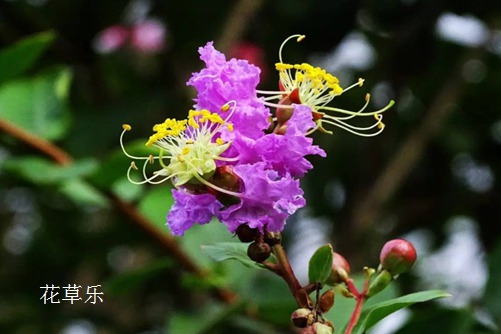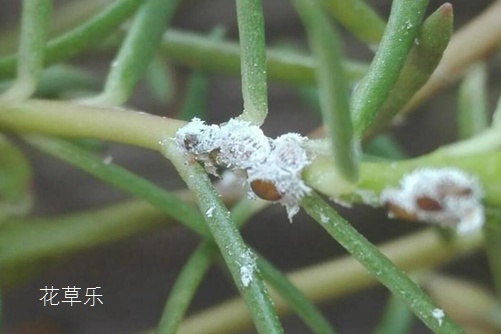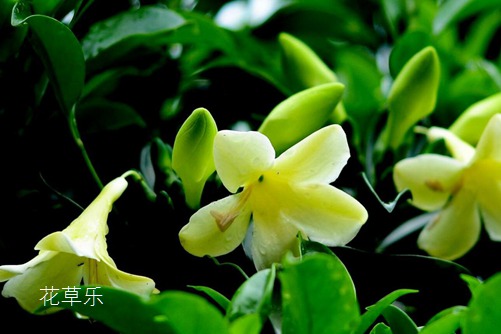Erkang, come and have a look at your crape myrtle-symptoms and control methods of diseases and insect pests in crape myrtle
"it is better to be as crazy as drunk and beautiful, and to be deceived by the wind. Who says there are no red flowers for a hundred days, and crape myrtle blossoms for half a year. " Yang Wanli
"crape myrtle", alias "hundred days red", has been the darling of the literati since ancient times. Yang Wanli's crape myrtle is lifelike, describing a vivid and beautiful picture for us. However, crape myrtle is easy to suffer from the erosion of diseases and insect pests, how to raise crape myrtle to better control diseases and insect pests? Next, Huacao Le will share with you the symptoms and control methods of crape myrtle flower diseases and insect pests.
Erkang, come and have a look at your crape myrtle-symptoms and control methods of diseases and insect pests in crape myrtle

I. powdery mildew of crape myrtle
Crape myrtle powdery mildew is common in the provinces and cities where crape myrtle is planted in our country. at the beginning of the disease, small white powder spots appear on the leaves, which are enlarged into round or irregular faded patches, which are covered with a layer of white powdery mildew, and the white powdery mildew layer turns gray in the later stage. After the flower is infected, the surface is covered with white powder layer, the flower spike is deformed and loses its ornamental value. The plants affected by powdery mildew will become short, the tender leaves are twisted, deformed and withered, the leaves do not develop, become smaller, the branches are deformed and so on, and the whole plant will die in serious cases. After the disease, the leaves of crape myrtle are often withered and yellow, which directly affects the tree potential and ornamental effect.
Prevention and control methods: (1) spray Baume 3-4 °stone sulfur mixture before sprouting in spring; (2) spray 1500-fold solution of 80% Dysen zinc wettable powder or 1000 times of thiophanate methyl, or 1500 times of 20% triadimefon EC, or 50% carbendazim wettable powder.
II. Crape myrtle brown spot
Brown spot is a disease that often occurs in the growing season of crape myrtle. At the initial stage of the disease, the spot is round or nearly round in different sizes, with a few irregular shapes. The disease spot is purplish black to black, the edge color is lighter, and then the color of the disease spot deepens, showing black or dark black, which is clearly separated from the healthy part. In the later stage, the central color of the lesion turned pale and was covered with gray-black mildew spots. When the disease is serious, the disease spot is connected into a piece, and the whole leaf turns yellow rapidly and falls off in advance. When the brown spot is serious, it often leads to a large number of withered and shedding of plant leaves, affecting ornamental and flowering. Prevention and treatment methods: (1) at the initial stage of the disease, 50% carbendazim wettable powder can be sprayed, or 65% Dysen zinc wettable powder 1000 times, or 75% chlorothalonil wettable powder.
Crape myrtle coal fouling disease
Coal fouling disease, also known as soot disease, infects crape myrtle mainly after it is harmed by crape myrtle scale and crape myrtle aphid, that is, the mucus excreted by them is used as nutrition to induce the mass reproduction of coal fouling bacteria. After the disease, the leaves of diseased plants are covered with black mildew layer, which not only affects the ornamental value of crape myrtle, but also affects the photosynthesis of leaves, resulting in plant growth weakness and early defoliation.
Prevention and control methods: timely control of aphids, scale insects, whitefly and so on, because the secretion of these insects is the basis of the pathogen of coal pollution disease. The commonly used agent is stone-sulfur mixture, Baume 3 °stone-sulfur mixture in winter and 0.3 °stone-sulfur mixture in summer and autumn. It can also be prevented and treated with trithione and litsea cubeba leaf juice. Or spray 50% carbendazim wettable powder 500 times 800 times, 70% methyl mop 500 times, and so on.
4. Aphids
Five to eight generations occur every year in northern China, with eggs overwintering near buds and shoots, May is the initial stage of the disease, and June is the peak period, nymphs and adults damage the young leaves of crape myrtle, prick and suck juice, affecting growth and development.
Control methods: strengthen cultivation and management measures, reduce the source of disease, when the number of aphids is large, spray 40% omethoate, 40% acephate 1000 × 1500 times or spray fish rattan essence 1000 × 2000 times, but pay attention to avoid drug damage.
5. Runosuke
Female adults and nymphs suck juice on bud axils, leaves and branches, resulting in blackening of branches and leaves, falling off leaves, seriously affecting the growth and development of trees, and their excreta can induce coal fouling disease, which is one of the main pests harmful to crape myrtle.
Control methods: spray 10 times 15 times turpentine mixture or 40 times 50 times engine oil emulsion for 3 times in winter to eliminate overwintering female insects. Before germination, spray 3% 5% stone sulfur mixture or 3% 5% diesel emulsion to eliminate overwintering nymphs.
VI. Big decayed moth
The big decay moth is also one of the pests that invade crape myrtle. The larvae bite leaves, shoots or peel off branches and fruit cortex in the protective capsule, resulting in local bald trees.
Control method: remove the protective capsule, when the larvae appear at the beginning of May to June, spray with 1000 times liquid of trichlorfon, the effect is very good.
Seven and 28 star ladybugs
Potato ladybugs, also known as Big 28 Coccinella beetles, produce 1-2 generations a year. When the temperature rises to 15-16 ℃ in spring, adult damage and spawning can be seen from the beginning to the potato harvest. Because of the overlap of generations, it is difficult to grasp the obvious occurrence peak in practice, and the control of insect population in the middle and later stage is the key to the control of the insect.
Prevention and control methods:
The main results are as follows: (1) the egg blocks are removed artificially during the oviposition period of adults. Taking advantage of the false death of the insect, the plants were slapped sooner or later to collect the fallen adults and larvae.
(2) after harvest, the crape myrtle flower should be treated in time to eliminate the residual insect source in the residual plant.
(3) Pesticide control should be carried out during the peak period of adult migration or larval hatching. 25-50g of 50% Badan soluble powder, or 5% Yitaibao EC 30-60ml, or 2.5% Kung Fu EC 20-40ml, or 40% methyl phoxim EC 25-50ml should be used for water spray control every 667m2.
Summary:
Crape myrtle is people's favorite ornamental flowers and trees, which can be planted in the courtyard at home, and small plants can also be planted in pots to decorate and beautify the house. it can watch and purify the air, and it is a good helper for a beautiful environment at home. It is said that if your home is full of crape myrtle flowers, the crape myrtle fairy will take care of you and give you happiness for the rest of your life. Flowers and plants wish you happiness all your life.
Time: 2019-04-29 Click:
- Prev

Sunflower infected with shell insects how to treat, do not need pesticides can eliminate shell insects seven tricks
Sunflower, a perennial flower of Portulaca genus of Portulaca family, is an annual succulent herb. Plant height 10~15cm. The petals are bright in color, such as white, dark yellow, red, purple and so on. There are many varieties of horticulture, including single, semidouble and double. Like a warm, sunny and dry environment
- Next

What if African jasmine leaves turn yellow? learn the following tips so that you no longer have to worry about African jasmine leaves.
African jasmine is a plant that many people like, thick green, give people a vibrant feeling, very fresh, is a very good ornamental plant. Now many people will raise African jasmine at home, but in the process of improper maintenance, there will be symptoms such as yellowing leaves, so what about African jasmine leaves yellowing?
Related
- Fuxing push coffee new agricultural production and marketing class: lack of small-scale processing plants
- Jujube rice field leisure farm deep ploughing Yilan for five years to create a space for organic food and play
- Nongyu Farm-A trial of organic papaya for brave women with advanced technology
- Four points for attention in the prevention and control of diseases and insect pests of edible fungi
- How to add nutrient solution to Edible Fungi
- Is there any good way to control edible fungus mites?
- Open Inoculation Technology of Edible Fungi
- Is there any clever way to use fertilizer for edible fungus in winter?
- What agents are used to kill the pathogens of edible fungi in the mushroom shed?
- Rapid drying of Edible Fungi

